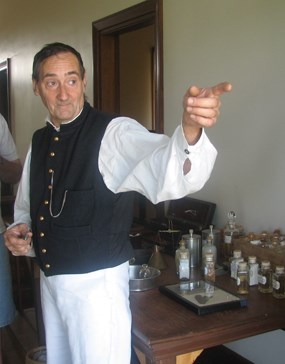
Doctors performed amputations for most limb injuries including broken bones, fractures, and gunshot wounds. Although anesthetics such as chloroform and ether were discovered in 1846, techniques were not perfected until the Civil War. Unable to control the effects of anesthesia and wary of its use, surgeons treated most patients without sedation or pain relief in the 1840s. Surgery, especially for wounds acquired from battle, required the skills of the physicians, but patients who survived the knife sometimes died for a lack of proper sanitation. It was not until after the Civil War that an understanding of the importance of sterilization would come. The soldier who suffered a wound or required surgery was much to be pitied. Even as late as the Civil War in the nation's capitol, the worst conditions existed: …Large mahogany boxes held the instruments; and the heavy center table was covered with a freshly wiped rubber cloth. But asepsis was not understood. The surgeon rolled up his sleeves, gave his knife a last flick on the sole of his boot, and the operation began. His exploring hands wore no gloves. The probe carried the infection deep into the torn tissues. If one of the sponges, employed to mop out the wound, happened to drop onto the floor, it was squeezed in water and used at once; and, in any case, only a cursory washing had cleansed it of the blood and pus of the last operation. In threading the needle for the stitches, it was customary to point the silk by wetting it with saliva and rolling it with the fingers. Cold water was the sovereign dressing; bad wounds were repeatedly drenched to relieve the burning pain. Sometimes the wound was covered with wax; or ointments were applied on lint which bad been scraped from cotton cloth by the patriotic but unsterile hands of women and children. Poultices of flaxseed meal or moistened bread were valued for promoting an abundant flow of pus, for all wounds were expected to suppurate. Blood poisoning, tetanus, secondary hemorrhage and gangrene were familiar visitors in the finest of the shining, whitewashed new pavilions of which Washington was so proud, and helped to fill the pine coffins which went jouncing in the dead carts to the cemetery. Reveille in Washington 1860-65 Few early hospitals had operating rooms. Surgery was performed on a mess table wherever convenient. Attendants left to administer brandy or stimulants to the sick sometimes drank the liquor themselves to the neglect of the patient. Amputation was common, especially if there were a compound fracture involved, if the bullet had entered a joint, or if there was uncontrolled bleeding and crushing of arteries and nerves. Two methods of amputation included circular amputation where cuts were made straight through the limb and flap amputation which involved diagonal cuts in the limb so that there would be a flap of skin left behind to fold over the stump. SURGICAL TOOLS The following tools are found in our surgeon's operating kit.

Amputating Knives - single edged knives used for cutting or incising soft tissue during the amputation. The first cut would be through the skin only. The skin would then be drawn back and a second cut would be made through muscle tissue. These were used for the most part in the Circular Amputation technique. Catlins - double edged knives used in the Flap Type of amputation procedure.
Surgical Scalpels - for incising and dissecting smaller, more delicate tissue. (Top and Bottom)
Bistoury or Hernia Knife - a longer and more slender scalpel. Some had blunt ends so that they could be used in wounds without puncturing arteries or vital organs. (Middle)
Tenaculum - for pulling out the arteries from the stump in order to tie them off.
Metacarpal Saw (top)
Lifting Back-Metacarpal Saw - used for cutting through smaller bones such as the rib, finger, toe ankle, or wrist. (bottom)
Capital Saw - severed the larger, long bones such as the leg and arm.
Scissors-Curved - for cutting tissue, also used for cutting bandage material.
Bone Forceps - for removing loose pieces of bone that could cause infection.
Nelaton's or Foreign Body Probe - to locate foreign bodies such as bullets or bone fragments in wounds. The end is blunt to avoid injuries to arteries. vein, or nerve tissue.
Straight Gnawing Forceps or Rongeur - used to remove rough bony edges on the stump after an amputation. (Top)
Bone File - used for removal of rough edges of bone after cutting by a saw, which would otherwise hinder healing and cause infection.
Tourniquet - to reduce the amount of hemorrhage during surgical techniques. They put pressure on an artery, thereby limiting the amount of circulating blood in the area.
The information for this section was taken from the Historic Furnishing Report for The Hospital by Sally Johnson Ketcham. Civil War Medical Instruments and Equipment, Vol. 1 by Dr. Gordon Dammann (used by permission). Civil War Medicine, 1861-1865 by C. Keith Wilbur, M.D (used by permission). |
Last updated: October 18, 2017

